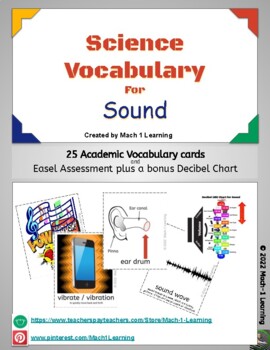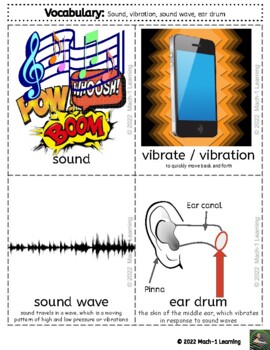Science Vocabulary for Sound
- PDF
- Easel Assessment
Also included in
- This bundle includes several lessons for exploring Sound Energy. The STEAM activities integrates the scientific process, journal writing, art, music, and PE activities. It is geared toward the 1st and 4th grade NGSS standards. The lessons are great for a substitute.Sound is a type of energy made upPrice $4.99Original Price $6.43Save $1.44
Description
Understanding the academic vocabulary for Sound Energy can be challenging. This product provides pictures with the scientific academic terms. It also includes an Easel Assessment that can be given before starting the lesson to determine the level of prior knowledge of your students and as a summative assessment. The 25 vocabulary terms included are: absorption, acoustics, ambiance, amplifier, amplitude, decibel, ear drum, echo, frequency, hertz, loudness, medium, pinna, pitch, reflection, resonance, sonic boom, sound energy, sound waves, speed of sound, vibrate, vocal cords, volume, wavelength, and wave speed.
Included in this Package:
- 25 Vocabulary Cards
- A Decibel Chart for sound
- An Easel Quiz for a pre-assessment and summative assessment (Note to Easel Teachers: This assessment was designed for you to select the options of Random Question order and Random Answer order)
Brief Overview:
Sound is a type of energy made up of vibrations, or sound waves, that we use our sense of hearing to understand. The sound waves are made from an object vibrating, or moving back and forth very quickly. These sound waves travel through air, water, and other matter.
We use our ears to hear sound. Our ears have a delicate skin on the inside that vibrates like a drum. Our brain recognizes this vibration as sound.
Objective:
- Understanding that sound energy has unique academic vocabulary that explains, describes, and are terms of measurement.
Suggested use:
- Word walls
- Flash cards
- Quiz-Quiz-Trade review
- Open Sort of cards where the students determine the categories (great hook before starting this science topic)
- Sort cards into the categories of measurement and description
- Jeopardy category - Teacher reads the definition; students respond with the vocabulary term “What is …”
Other TpT products that support Sound Energy:
- Sound Energy Bundle (Growing Bundle) - Finding time for Science is always a challenge for teachers. This growing bundle allows your students to explore that scientist are readers, writers, mathematicians, artist, and even need exercise to keep their minds focused. It is great for a substitute.
- Introduction to Sound Wave (STEAM) - students will explore that vibrations are responsible for the sounds we make and hear
Standards:
1-PS4-1: Plan and conduct investigations to provide evidence that vibrating materials can make sound and that sound can make materials vibrate.
4-PS4-1: Develop a model of waves to describe patterns in terms of amplitude and wavelength and that waves can cause objects to move.
Terms of Use:
This resource was created for Mach-1 Learning. All rights reserved. It may be used by the original purchaser for a single class use. Teacher may distribute this product via a Course Management System (CMS) that is password protected. It must not be posted on the internet where it could be publicly found and downloaded. If you want to share this resource with colleagues, please purchase additional licenses from TpT. Thank you for respecting these terms of use.






